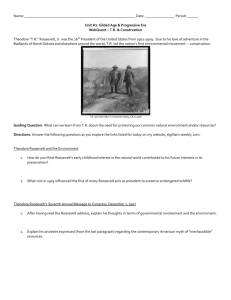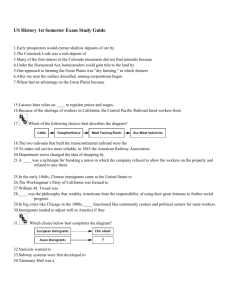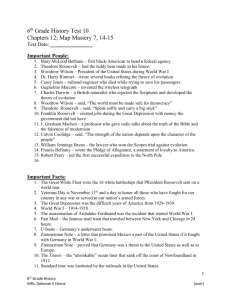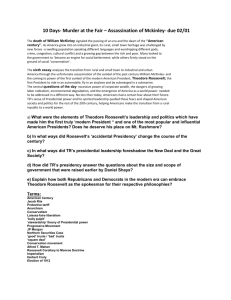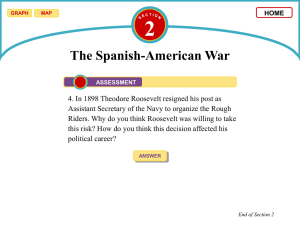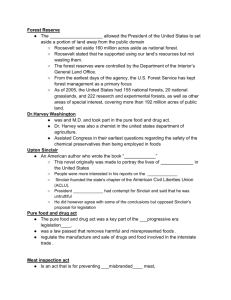Camping Trip Lesson Plan Social Studies Conference
advertisement
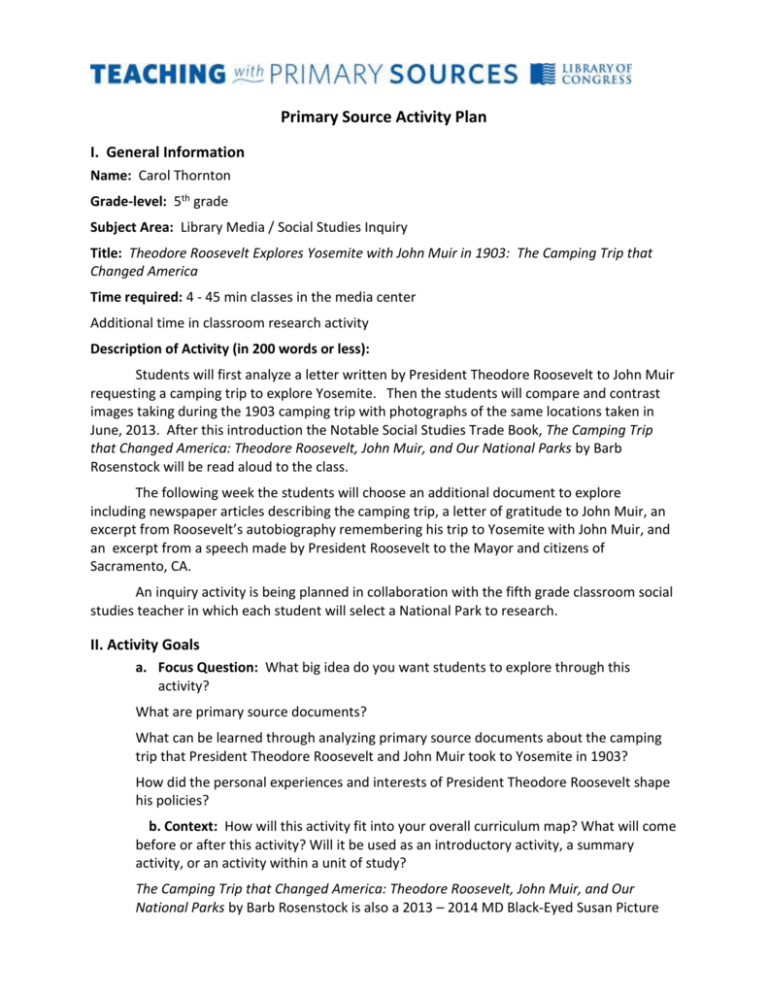
Primary Source Activity Plan I. General Information Name: Carol Thornton Grade-level: 5th grade Subject Area: Library Media / Social Studies Inquiry Title: Theodore Roosevelt Explores Yosemite with John Muir in 1903: The Camping Trip that Changed America Time required: 4 - 45 min classes in the media center Additional time in classroom research activity Description of Activity (in 200 words or less): Students will first analyze a letter written by President Theodore Roosevelt to John Muir requesting a camping trip to explore Yosemite. Then the students will compare and contrast images taking during the 1903 camping trip with photographs of the same locations taken in June, 2013. After this introduction the Notable Social Studies Trade Book, The Camping Trip that Changed America: Theodore Roosevelt, John Muir, and Our National Parks by Barb Rosenstock will be read aloud to the class. The following week the students will choose an additional document to explore including newspaper articles describing the camping trip, a letter of gratitude to John Muir, an excerpt from Roosevelt’s autobiography remembering his trip to Yosemite with John Muir, and an excerpt from a speech made by President Roosevelt to the Mayor and citizens of Sacramento, CA. An inquiry activity is being planned in collaboration with the fifth grade classroom social studies teacher in which each student will select a National Park to research. II. Activity Goals a. Focus Question: What big idea do you want students to explore through this activity? What are primary source documents? What can be learned through analyzing primary source documents about the camping trip that President Theodore Roosevelt and John Muir took to Yosemite in 1903? How did the personal experiences and interests of President Theodore Roosevelt shape his policies? b. Context: How will this activity fit into your overall curriculum map? What will come before or after this activity? Will it be used as an introductory activity, a summary activity, or an activity within a unit of study? The Camping Trip that Changed America: Theodore Roosevelt, John Muir, and Our National Parks by Barb Rosenstock is also a 2013 – 2014 MD Black-Eyed Susan Picture Book nominee. Maryland students who read or listen to a minimum of 8 books from this list may vote for their favorite. This is a program that my 1 st through 5th grade students participate in each year. After each selection is read an activity in the media center extends the students’ learning and appreciation of the particular book. This book not only fits into my media curriculum it is also a perfect place to introduce the analysis of a variety of primary source documents. After the lessons in the media center the 5th grade social studies teacher will direct the students in a research project on the National Parks. Each student will choose a National Park of interest to them to investigate. c. Objectives: What content and critical thinking skills do you want students to gain as a result of this activity? The students will be able to discern the difference between primary and secondary sources. They will analyze a variety of primary source documents including identifying the location, date, source, and construct an interpretation of the historical event. Other thinking skills include the process of reflection, questioning, and making connections to their own lives. An individual investigation of a National Park of their choice with specific content objectives will be an extension of this activity. d. Assessment: How will you measure student mastery of the objectives? Students will: Create a list of different types of primary source documents Complete the Primary Source Analysis Tool Complete a “Double Bubble” Thinking Map Observation of student engagement and participation in discussions III. Activity Details a. Primary Sources: List the Library of Congress primary source(s) used. Include the title and URL of the item(s). Include a thumbnail image of each primary source. 1. “Letter of Theodore Roosevelt to John Muir.” 14 March 1903, ser 2, vol. 39, p. 101, reel 330, TR papers, MMS, LOC.jpg 2. Theodore Roosevelt and John Muir on Glacier Point, Yosemite Valley, California, in 1903. http://www.loc.gov/pictures/item/93503130/ 3. President Roosevelt's choicest recreation - amid nature's rugged grandeur on Glacier Point, Yosemite http://www.loc.gov/pictures/item/2010647431/ 4. Travels to Yosemite, June 2013 b. Activity Procedure: Describe your activity steps, including and especially analysis of primary source(s) here. Please also note any Institute strategies or activities you will draw on. 1. Review the differences between primary and secondary sources. Students will create a list of a variety of types of primary source documents. 2. Provide a copy of the “Letter of Theodore Roosevelt to John Muir” to each pair of students. Students will consider the purpose of Roosevelt’s letter. How might Roosevelt’s goals to take a camping trip be similar or different from Muir’s? Students will complete the Primary Source Analysis tool. 3. As a whole group discuss observations, reflections, and questions generated by this activity. 4. Model the “Double Bubble” Thinking Map activity noting the similarities and differences in a pair of images of the same location (Theodore Roosevelt in 1903 and Carol Thornton in 2013) 5. Students return to their partner to create a “Double Bubble” Thinking Map with additional images. 6. As a whole group discuss observations, reflections, and questions generated by the image analysis activity. As students share the differences they noticed ask how these differences relate to the history of the National Parks. As an example in the group photograph (2013) the people are sitting on a wall. Sidewalks, walls, hand rails, visitor centers and many other features have been constructed to make the National Parks assessable to all visitors. Also, have the students to think about the differences between taking a photo in 1903 vs. 2013. Consider the differences in the cameras and the audience each photographer had in mind. What “story” is each photo trying to tell? What do the photos tell us about Yosemite and the National Parks? Images of Roosevelt’s camping trip were published in newspapers with a national audience while I created a photo book to share with my travel group, family, friends, and students. Roosevelt explored the Yosemite wilderness returning with a determination to preserve these lands for future generations. Visitors today benefit from Roosevelt’s efforts. However, controversies between wilderness preservation and making the parks available to visitors remain. For example, I was told by our group leader, who has ascended Half Dome over 80 times in his life, that hikers today must obtain a permit. The trail simply cannot accommodate the increasing number of people wanting to make this climb. The permits sell out in a couple of days for the entire year making the limited permits difficult to acquire. 7. Ask the students if the picture book, The Camping Trip that Changed America: Theodore Roosevelt, John Muir, and Our National Parks by Barb Rosenstock, is a primary or a secondary source. How did the author go about creating this book? Share the bibliography and examine the sources. In an interview about the writing process, Rosenstock emphasized the importance of research. She read three or four adult biographies on each man and many newspaper articles. (Students will examine some of the same newspaper articles in Day 2 of this lesson plan). When actually visiting Yosemite and the library there, Rosenstock found a description of Muir’s gravesite and then made the decision to make trees the book’s central theme. After the book was published she even visited Muir’s grave. 8. Read the book aloud to the class. 9. Conclude with a discussion of insights learned from listening to the picture book. Were questions answered or further questions generated? How did the personal experiences and interests of President Theodore Roosevelt’s camping trip shape his policies about preserving our nation’s wilderness areas? 10. Inform the students that the next class will involve analyzing additional primary source documents describing this camping trip including: newspaper article "President Makes Camp at Bridal Veil Falls," The Call (San Francisco, CA), May 18, 1903, Page 1, Image 1, col. 5-7. thank you letter to John Muir excerpt from Roosevelt’s autobiography excerpt from speech made in Sacramento, CA on May 19, 1903. 11. Remind the students to be thinking about a National Park they would like to learn more about. IV. Considerations before Implementation a. How will others collaborate in your implementation? The fifth grade social studies teacher will direct the students in an individual inquiry project researching a selected National Park following the lessons in the media center.
